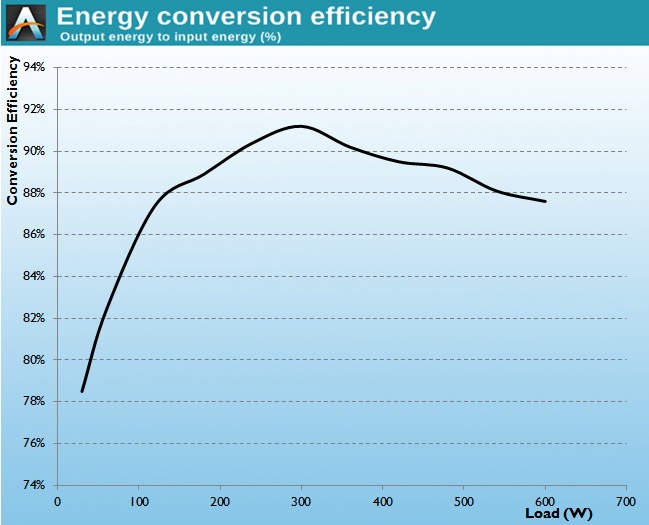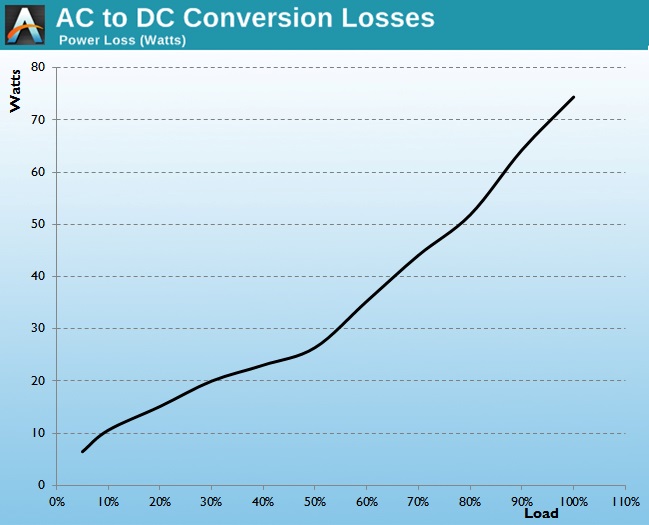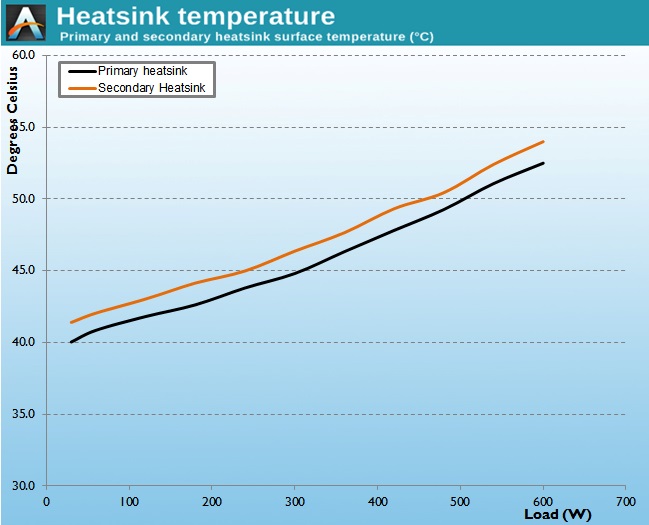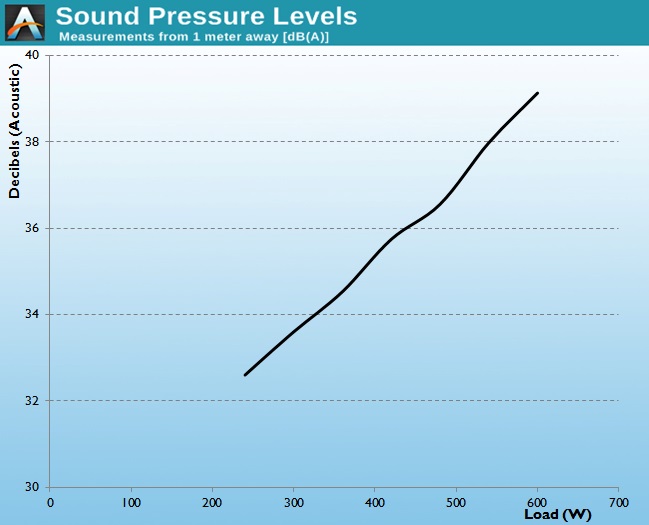The SilverStone SX600-G SFX PSU Review
by E. Fylladitakis on August 21, 2015 8:00 AM EST- Posted in
- PSUs
- Cases/Cooling/PSUs
- 80Plus Gold
- SilverStone
- SFX
- 600W
- Enhance
Cold Test Results
For the testing of PSUs, we are using high precision electronic loads with a maximum power draw of 2700 Watts, a Rigol DS5042M 40 MHz oscilloscope, an Extech 380803 power analyzer, two high precision UNI-T UT-325 digital thermometers, an Extech HD600 SPL meter, a self-designed hotbox and various other bits and parts. For a thorough explanation of our testing methodology and more details on our equipment, please refer to our How We Test PSUs - 2014 Pipeline post.
The efficiency of the SilverStone SX600-G is very good but it does not actually meet the 80Plus Gold certification standards under 230V AC input. It is very likely that it does with an input of 110V/60Hz AC, which admittedly is what was used to certify this PSU in the first place. We measured a maximum efficiency of 91.2% at 50% load and an average efficiency across the entire nominal load range (20% to 100% of the unit's capacity) of 89.2%. It is interesting to note that the low load efficiency of the SX600-G is quite good, with an efficiency reading of nearly 79% at just 5% load.
This PSU sports a semi-fanless design, meaning that the fan will start only after the temperature exceeds a certain point. For a densely packed SFX unit, that point as it turns out is not very high, with the fan kicking in shortly after 200W in our room temperature environmental test. Still, the internal temperatures of the SX600-G remained relatively low and the fan did not have to get loud. Even at maximum load, the fan stopped at 39.1 dB(A), a clearly audible but borderline comfortable figure.















20 Comments
View All Comments
meacupla - Friday, August 21, 2015 - link
From personal experience, the SATA cables they include aren't suitable in their own cases, at least not in RVZ01.Right angle SATA connectors are completely inferior compared to straight ones inside cramped cases, because the "T", that theconnector forms with its cables, gets in the way more often than not and causes a lot of stress onto the drive connector or the cables.
The right angle SATA connectors are so bad, in fact, that I am forced to use 4-pin molex to straight SATA cables, which adds further clutter inside an already cramped case.
edzieba - Friday, August 21, 2015 - link
The downside of straight connectors is that you now need to accommodate the Minimum Bend Radius behind the drive for the cable to make a 90° turn (extra wasted space), and you need to run DOUBLE the number of actual wires through the case (due to the lack of daisy-chaining).meacupla - Friday, August 21, 2015 - link
no you don't? There are daisy-chained straight SATA connectors. This was a pretty standard type of connector found on older PSUs, but for some reason, I haven't seen many, and by that I mean none, these days.This is the perfect solution, daisy chain straight connectors: http://cdn.overclock.net/a/a8/a8f3a740_2012-12-09_...
You see, the problem with right angle connectors, is that you need accommodate the minimum bend radius between the drives anyways, because these connectors aren't spaced to the typical drive spacing.
And also, I would like to stress that 'right angle' power connectors are the 'wrong angle' in RVZ01. The 2.5" drives are belly up. The "right" angle connectors protrude above the side panel.
Margalus - Friday, August 21, 2015 - link
both types of connectors suffer from the same problems with Minimum Bend Radius, just in different situations.as for daisy chaining straight connectors, I haven't seen one with several straight connectors, I don't see how that would even be possible. The one you show just shows a single connector at the end like typical straight connectors, not several daisy chained together like you can have with the 90° cables.
not saying 90° cables are better, or that straight cables are better. they both have their uses.
geniekid - Friday, August 21, 2015 - link
More SFX/SFX-L reviews!Flunk - Friday, August 21, 2015 - link
So in summation, if you want a 600W SFX power supply you have to buy this one.About the cables, Silverstone uses the same standard for all their modular cables and has for quite a while. They offer a wide range of replacement cables in different lengths and even single cables. Not only that if you buy a bunch of their power supplies you end up with a bunch of extra cables. That's a great reason to keep buying their products. The last 4 power supplies I've bought were Silverstone, mostly so I can mix and match cables with my existing collection if I need a longer/shorter one.
meacupla - Friday, August 21, 2015 - link
Actually, Athena Power has a bunch of SFX PSUs that are over 600W and they even have an 800W model.Silverstone is also going to release a 700W model of their SST-SX500-LG, although, strictly speaking, these "Long" models don't conform to SFX standards.
Personally, I don't see how or why you would want more than 500W, because I'm quite sure you would run into thermal issues with a CPU+GPU that would require that kind of power in a case these SFX PSUs are designed to go in.
BrokenCrayons - Friday, August 21, 2015 - link
First off, thanks for reviewing power supplies of lower wattage and it's great to see Anandtech taking a look at SFX PSUs in particular. Not all of us are interested in 1000 watt supplies so the variety is great.But I did notice..."The OEM behind the *very* densely packed design you see below is Enhance. Enhance is not a *very* common manufacturer for *very* high output PSUs..." this review contained a lot of "very" and "relatively" which hurt readability somewhat.
Ryan Smith - Friday, August 21, 2015 - link
Yeah, we did go a bit overboard there. Thanks for pointing it out.ruthan - Friday, August 21, 2015 - link
2 year ago i looked for SFX PSU and only choice was Seasonic 300W and even with 30W power outcome was noise. So i moved into expensive picoPSU and after that for second very small machine i selected board with laptop like external adapter connector and adapter bundled with Akasa Euler S.Usually if you case about size, you want to have machine near of you and it means machine should be quiet.. So for smaller power consumation (<200W) machine there are better laptop like solution and for bigger machines is still ATX PSU needed.. or maybe there are some niche never where reviewed extendar passively cooler 300W boxes.. - but there are not small, so..